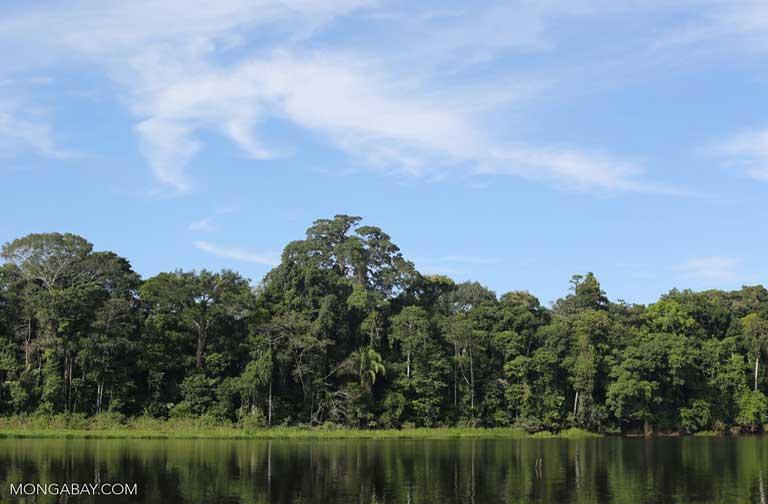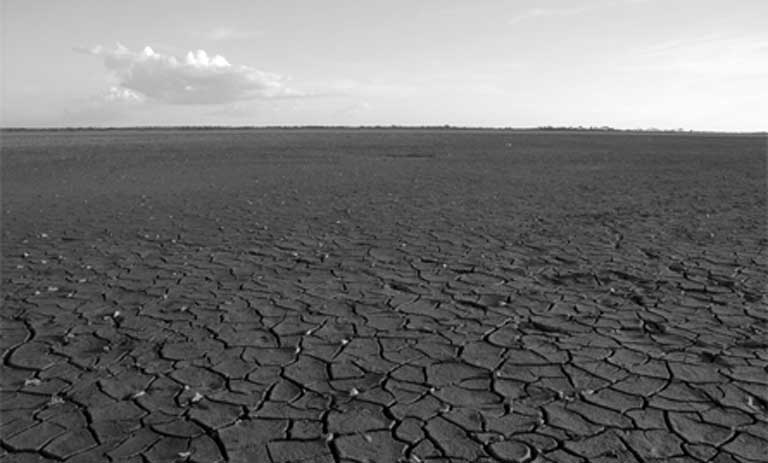- Amazonian manatees (Trichechus inunguis) spend the high-water season feeding in flooded forests, but migrate to deeper permanent water bodies to see out the dry season.
- Researchers have found that as the dry season approaches, manatees time their migration out of the floodplain to avoid bottlenecks that would block their route, and doom them.
- But, the scientists warn, those bottlenecks will become far more common, and less predictable, if the hundreds of hydropower dams planned for the Amazon go forward.
- The dams, and the bottleneck problem they create, “generates profound concern for the conservation of manatees,” the scientists write.

After a day of feverishly hard work to free his boat from Amazon basin mud, scientist Eduardo Arraut suddenly became inspired to study the timing — and hazards — of Amazonian manatee migration.
Arraut, a Brazilian biologist, was doing fieldwork and travelling by boat along river channels connecting two lakes in the floodplains of Brazil’s western Amazon. As the dry season approached, water levels dropped and Arraut found his route blocked where a channel had gone dry. Three hours spent hauling his boat across 300 meters of mud caused Arraut to wonder how the local manatee population timed their journey along the same route to avoid getting stuck.
Amazonian manatees (Trichechus inunguis) spend the high-water season feeding on vegetation in the region’s flooded forests but then migrate to deeper permanent stretches of water to see out the dry season. Although food is scarce in these deeper lakes, remaining in the shallower, isolated lakes of the floodplain would leave manatees vulnerable to both human and jaguar attacks.

In his subsequent study, Arraut, of the Wildlife Conservation Research Unit at the University of Oxford, and his colleagues, found that bottlenecks like the one that blocked his boat are a frequent occurrence along manatee migration routes.
And, the researchers warn, those dry season bottlenecks will certainly become more common, and less predictable, if the hundreds of hydropower dams planned for the Amazon go ahead — adding another serious stressor to this already threatened species.
The study, published in Acta Amazonica, focused on the floodplain lakes and channels connected to Lake Amanã, in the mid-Solimões region of the state of Amazonas, where water levels fluctuate by as much as 16 meters (over 50 feet) annually. Lake Amanã is a deep lake known as a ria, which serves as a manatee refuge during the dry season.

Arraut and his team combined radio-tracking data from 10 wild manatees (followed for various time periods between 1994-2006) with a detailed, three-dimensional depth study of the lakes and channels of their high- and low-water habitat. This data was complemented by satellite images at the peak low-water season each year, showing where bottlenecks formed, and calibrated with a hydrograph produced by a water gauge in one of the lakes.
Using this information, four bottleneck locations were identified, varying in length from 800 meters (more than 2,600 feet) to 10 kilometers (6.2 miles). Three of these occurred every year, or nearly every year, with the fourth occurring just twice between 1992 and 2005. Data also revealed a new 5 kilometer (3.1 mile) bottleneck created over the course of just 15 years.
The radio-tracking data allowed the research team to note when manatees started their migration, and to estimate the water depth of the bottlenecks when the animals passed through them. Migration began abruptly in almost every case, with manatees appearing to respond to local water depth as the signal to travel out of the lake. This precise timing meant that the manatees passed through the bottlenecks just a few days before they dried out, maximizing their time in the abundant feeding grounds of the floodplain lakes.
Timing it right is crucial, say the researchers, but this could become much harder — even impossible — if dams planned across the Amazon basin are built, something that “generates profound concern for the conservation of manatees,” the team writes.

Dams disrupt natural flood cycles and the flow of sediment downstream, which together shape the Amazon floodplain. The potential impact of multiple planned dams within just one of the Amazon’s sub-basins, the Tapajós, has been called a “crisis in the making.”
Although manatees are capable of responding to the dynamic nature of the floodplain, including the creation of new bottlenecks within their lifetimes, their behavioural adaptability is unlikely to be enough to survive the erratic water retention and release from the dams, explained Arraut, who is also affiliated with the Remote Sensing Division of the National Institute for Space Research, Brazil.
“First, if one looks at the systemic effect of these dams on the basin, the flooding will not only change, it will become quite unpredictable,” he said. “This unpredictability makes behavioural adaptation much harder. Second, many individuals will surely die before some of them have learned how to cope with this new environment, which is a problem for a species that is already threatened with extinction.”
The Amazonian manatee is classified as Vulnerable by the IUCN, a consequence of centuries of hunting after the European discovery of the Amazon, along with modern day local hunting, trade, and entanglement with fishing gear. (Six out of the ten radio-tagged manatees studied were hunted by local communities over the course of the research.) Dams can exacerbate these threats, as the human population — and therefore the demand for meat — increases during and after dam construction.

Amazonian manatees are “at serious risk of disappearing, once again on account of human actions,” said Maura Sousa, who studies manatee conservation in the Amazon estuary at the Federal University of Pará, and who was not involved with the study. “What once may have been a mistake, without any warnings of the dangers the species were facing” is now a clearly visible threat.
Beyond any single species, “the real issue at stake is a beautiful, complex and very [rich] ecosystem,” she added. Another major new study has determined that the many dams proposed for the Amazon Andes headwaters alone could be catastrophic for Amazon basin ecosystems and millions of people.
“One of the major problems with dams is their environmental impact studies,” which do not convey the extent of the damage that they will cause, Sousa said. “And even those [dams] that have predicted major damage to the ecosystem are still licensed.” In addition, the extreme lack of data about wild manatee populations “means hands are tied with regards to making claims about the threat a particular dam might impose upon them,” Arraut explained.

The downstream environmental impact of dams means that even if manatees are not directly affected by a dam’s construction, they may still suffer consequences in addition to altered flood cycles. Changes to water chemistry and sediment flows will, for example, affect the “growth of aquatic macrophytes, manatees’ staple diet,” said Miriam Marmontel, of the Mamirauá Institute of Sustainable Development and co-author of the study.
Dams “also create a more lentic [still water] environment, where mercury becomes more available to the food chain, and as macrophyte roots accumulate that metal, it may be transferred to manatees, with as yet undocumented but likely damaging consequences,” she said.
Because existing dams have mainly been built on rivers with rapids, which manatees cannot travel over, population subdivision is not yet a major problem, said Marmontel. But Arraut fears that if new dams are built, then manatees will be isolated upstream, downstream, or between the structures, making the animals vulnerable to “a suite of problems that affects small populations.”
For the manatees of Lake Amanã, dams are not an immediate threat because the closest rivers, the Solimões and Japurá, “are wide and devoid of falls,” Marmontel explained. But “as entrepreneurs run out of [dam site] possibilities in other rivers, they are looking into a series of smaller, sequential dams, that might be implemented even in lowland areas, such as the mid-Solimões River,” she said.

Arraut sees an uncertain future for manatees: “My feeling is that the outlook is quite dire for the Amazon as a whole. Having said this, Brazil is going through a very important cleansing process when it comes to institutional corruption, and internal and international pressure with regards to finding a less destructive plan for the Amazon [is] increasing.”
Aside from cancelling planned dams, and promoting an economy based on environmentally friendly livelihoods, “[p]erhaps the best conservation measure for manatees would be one that improved the lives, educational background, and environmental conscience of people in Brazil and elsewhere,” Arraut said. “One immediate consequence of this would probably be the abolishment of a development plan for the Amazon that sees it as a deposit of minerals, oil, gas and valuable wood.”
Both Arraut and Sousa agree that a better understanding of manatee populations is needed, because “we don’t even have a marginally reliable population estimate for the species,” said Arraut. Without that baseline data, it is impossible to gauge impacts as they unfold.
Getting local people on board with conservation efforts is another priority, said Sousa, who is involved with environmental education, along with manatee rescue and rehabilitation work.
Marmontel sees a brighter future, if the right actions are taken quickly. “After the commercial hunting period [in the past, manatees] became more nocturnal, shy and inhabitants of back, calm and quiet waters, where they keep reproducing,” she said. “If allowed favorable, pristine and protected habitat, manatees may share this planet with us for several [more] millions of years.”
Citation:
Arraut, E. M., Arraut, J. L., Marmontel, M., Mantovani, J. E., Novo, E. M. L. M. (2017) Bottlenecks in the migration routes of Amazonian manatees and the threat of hydroelectric dams. Acta Amazonica 47: 7-18
FEEDBACK: Use this form to send a message to the author of this post. If you want to post a public comment, you can do that at the bottom of the page.

